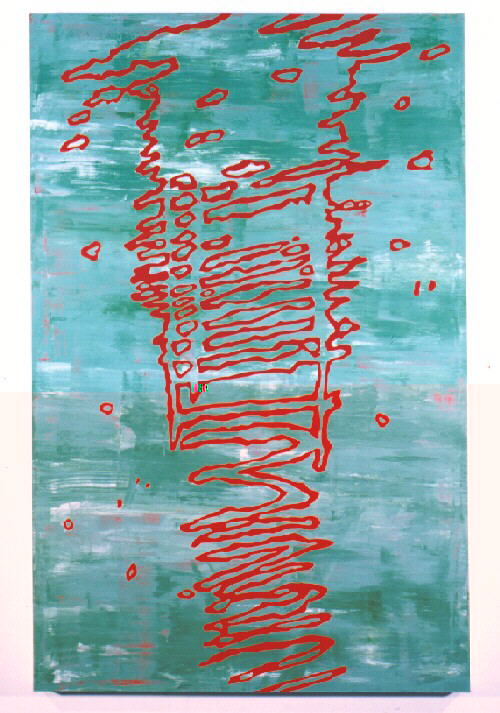
Jay Grimm's
Critical Review
New York
Mark Staff Brandl
Wartensee Castle
Much has been made by European critics of the fact that Mark Staff Brandl is both a painter and a critic. Indeed, his writing has frequently graced the pixels of this web site. Additionally, comment has often been heard that he has developed "backwards," from conceptual art into painting, that his influences seem to come equally from high and low cultural sources, and that he seems thoroughly "big city" American, yet has chosen to live primarily in a small European country. These descriptions, not always intended as complimentary, inadvertently strike at the heart of Brandlís art, as revealed in the two solo shows of paintings, drawings and prints he currently has in Switzerland.
Contradictory dichotomies thoroughly permeate Brandl's art. He intentionally yokes "contraries" in his handling, forms, compositions, even his method itself. An intellectual theoretician, his speculations result in surprisingly sensual works of art. His process while conceptual and Duchampian generates images of metaphoric richness. Recently invented materials and machines are utilized to nurture painting, that 20,000 year old quiddity. Elements of high and popular culture collide. Representation and abstraction plagiarize one another in his image making, while sheer presence countervails the planned.
The artistís accomplishment is obtained largely through his procedure, which is more of a modus operandi than a style. Brandl selects a characteristic aspect of the perceptual context and brings it back into our view. He enlarges lines, figures, strokes, or aspects of an image important to him in numerous steps and with a profusion of technologies, e.g. photographing, copying, faxing, computer print-out, etc, etc. Interference, 'noise', mistakes or irregularities come to the fore through this 'microscopying' technique. What are perceived as perfect contours in the source image prove to be far more complex in fractal magnification, dissolving and simultaneously resolving themselves. Broken-down details in zoom allow new structures to originate. The images resulting from this process are then painted. At first glance they seem to be free marks on the surface, yet reveal themselves upon closer inspection as forms painstakingly cut through layers of vigorously applied glazed paint. The figure is thus in fact revealed ground. Likewise in the drawings, the shapes are not expressively loose as one would at first suspect, but rather laboriously drawn in many layers.
Brandlís two current exhibitions are quite extensive, consisting in total of ten large paintings (most often 6 feet high by 4 feet wide), about fourteen medium-sized drawings ( 40 by 25 inches), three 5- foot by 5-foot wood cuts and twenty-five small drawings (usually 8 by 8 inches). The show in Heiden is all work from 1999; Castle Wartensee displays predominantly older works from 1997 to 1999. Many of the oil on canvas paintings are made up of multiple conjoined or inset panels, yet the most impressive are the two single panel pieces at Galerie W, Alluscivious and Allusciveroo.
The first of these is 76 x 41 inches (192 x 103 cm), the second 76 x 48 inches (192 x 123 cm), making them both roughly the dimensions of wide doors and lending them a distinctly human-like presence. The surface of Alluscivious is a diaphanously scraped and poured layering of blue-greys and off-whites. Innumerable fine, vertical rivulets seem to stream down the face of the painting. Through this skin Brandl has incised a contour composed of undulating three-quarter inch lines, revealing the subcutaneous black underpainting. The companion piece, Allusciveroo, bears a surface of horizontally-stroked layers of minty pastel green cut through to reveal the a substrata of magenta-flavored permanent rose. Both images call to mind ladders, comic-strip ghosts, watery reflections, or shadows on a glossy floor.
Brandl uses his images, tools and formats metaphorically ó often as metonymy or metalepsis ó deriving his forms and techniques from existing representations and "imaging" machines. He refuses to bow down to "new" media, seeing them instead as faulty but pleasing implements. Errors are cheerfully harvested as fodder for painting (of restituted interest, like the novel, because of its state of permanent crisis). This is a radical departure from the unities of Late Modernism or the ironies of Postmodernism. Brandl's antithetical contraries establish dynamic tensions, a buoyant dialog of opposite desires.
ó Daniel Ammann and Roman Schuenze